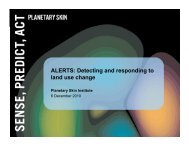ALERTS(beta) user guide - Planetary Skin Institute
ALERTS(beta) user guide - Planetary Skin Institute
ALERTS(beta) user guide - Planetary Skin Institute
You also want an ePaper? Increase the reach of your titles
YUMPU automatically turns print PDFs into web optimized ePapers that Google loves.
INPE – The Instituto Nacional de Pesquisas Espaciais is Brazil’s National<br />
<strong>Institute</strong> for Space Research. INPE is a core research partner of the<br />
<strong>Planetary</strong> <strong>Skin</strong> <strong>Institute</strong> and developed transitional risk and emissions<br />
models for the Brazilian Amazon that are available in the <strong>ALERTS</strong><br />
application.<br />
Land change – Refers to changes in land cover or land use as detected<br />
by the GOPHER algorithms.<br />
MODIS. The Moderate-Resolution Imaging Spectroradiometer, is a sensor<br />
on board two NASA satellites, Terra and Aqua. With its sweeping 2,330-<br />
km-wide viewing swath, MODIS sees every point on our world every 1-2<br />
days in 36 discrete spectral bands.<br />
NASA. The National Aeronautics and Space Administration is the space<br />
agency of the United States of America. NASA is a core research partner<br />
of the <strong>Planetary</strong> <strong>Skin</strong> <strong>Institute</strong>. In addition to providing valuable technical<br />
assistance and advice, NASA provided global data from the CASA<br />
ecosystem model to inform estimates of carbon stocks and flows in forests<br />
PSI. The <strong>Planetary</strong> <strong>Skin</strong> <strong>Institute</strong>. A non-profit organization founded to<br />
develop information technology-based tools for global resource and risk<br />
management.<br />
TCG. The Terrestrial Carbon Group, a network of scientists and policy<br />
researchers dedicated to helping reduce terrestrial carbon emissions<br />
through institutional design.<br />
Segmentation. One of the algorithms in the GOPHER family, identifying<br />
statistically significant model discontinuities in the vegetation signal of a<br />
specific area.<br />
Terra. A NASA Earth Science satellite mission carrying the MODIS sensor<br />
and delivering data products used to detect disturbances in the <strong>ALERTS</strong><br />
application.<br />
Transitional potential. A measure of the propensity of a particular area to<br />
transition from one land use to another, and in particular, from a forest to<br />
non-forest use.



